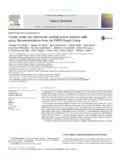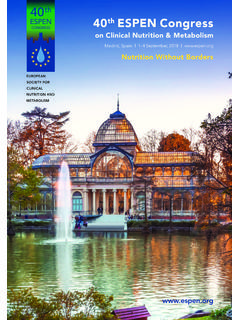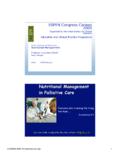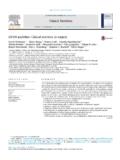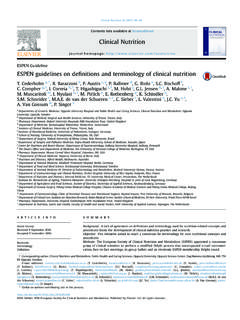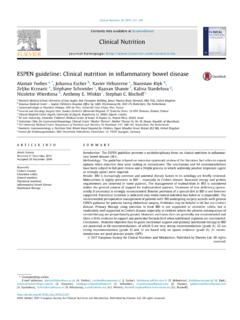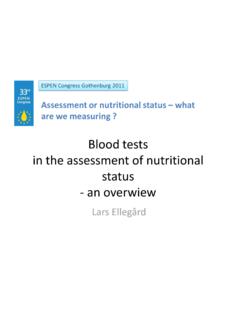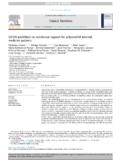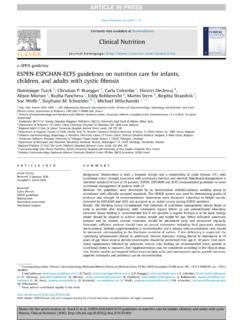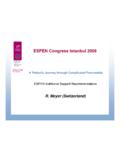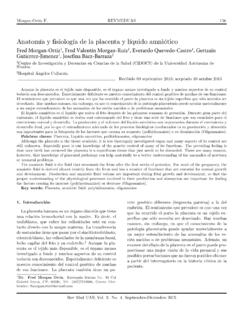Transcription of ESPEN guidelines on chronic intestinal failure in adults
1 E-SPEN guidelineESPEN guidelines on chronic intestinal failure in adultsLoris Pironia,*, Jann Arendsb, Federico Bozzettic, Cristina Cuerdad, Lyn Gillanderse,Palle Bekker Jeppesenf, Francisca Jolyg, Darlene Kellyh,i, Simon Lalj, Michael Staunf,Kinga Szczepanekk, Andr e Van Gossuml, Geert Wantenm,St ephane Michel Schneidern,the Home Artificial Nutrition& chronic intestinal failure Special Interest Group of ESPENaCenter for chronic intestinal failure , Department of Digestive System, St. Orsola-Malpighi University Hospital, Bologna, ItalybDepartment of Medicine, Oncology and Hematology, University of Freiburg, GermanycFaculty of Medicine, University of Milan, Milan, ItalydNutrition Unit, Hospital General Universitario Gregorio Mara~n on, Madrid, SpaineNutrition Support Team, Auckland City Hospital, (AuSPEN)
2 Auckland, New ZealandfRigshospitalet, Department of Gastroenterology, Copenhagen, DenmarkgCentre for intestinal failure , Department of Gastroenterology and Nutritional Support, H^opital Beaujon, Clichy, FrancehDivision of Gastroenterology and Hepatology, Mayo Clinic College of Medicine, Rochester, MN, USAiOley Foundation for Home Parenteral and Enteral Nutrition, Albany, NY, USAjIntestinal failure Unit, Salford Royal Foundation Trust, Salford, UKkGeneral and Oncology Surgery Unit, Stanley Dudrick's Memorial Hospital, Skawina, PolandlMedico-Surgical Department of Gastroenterology, H^opital Erasme, Free University of Brussels, BelgiummIntestinal failure Unit, Department of Gastroenterology and Hepatology, Radboud University Nijmegen Medical Centre, Nijmegen, The NetherlandsnGastroenterology and Clinical Nutrition, CHU of Nice, University of Nice Sophia Antipolis, Nice, Francearticle infoArticle history:Received 25 January 2016 Accepted 27 January 2016 Keywords.
3 GuidelineIntestinal failureHome parenteral nutritionIntestinal transplantationShort bowel syndromeIntestinal pseudo-obstructionsummaryBackground&aims : chronic intestinal failure (CIF) is the long-lasting reduction of gut function, belowthe minimum necessary for the absorption of macronutrients and/or water and electrolytes, such thatintravenous supplementation is required to maintain health and/or growth. CIF is the rarest organ parenteral nutrition (HPN) is the primary treatment for CIF. No guidelines (GLs) have beendeveloped that address the global management of CIF.
4 These GLs have been devised to generatecomprehensive recommendations for safe and effective management of adult patients with :The GLs were developed by the Home Artificial Nutrition& chronic intestinal failure SpecialInterest Group of ESPEN . The GRADE system was used for assigning strength of evidence. Recommenda-tions were discussed, submitted to Delphi rounds, and accepted in an online survey of ESPEN :The following topics were addressed: management of HPN; parenteral nutrition formulation; intestinal rehabilitation, medical therapies, and non-transplant surgery, for short bowel syndrome, chronic intestinal pseudo-obstruction, and radiation enteritis; intestinal transplantation; prevention/treatment of CVC-related infection, CVC-related occlusion/thrombosis.
5 intestinal failure -associated liverdisease, gallbladder sludge and stones, renal failure and metabolic bone disease. Literature search pro-vided 623 full papers. Only 12% were controlled studies or meta-analyses. A total of 112 recommenda-tions are given: grade of evidence, very low for 51%, low for 39%, moderate for 8%, and high for 2%;strength of recommendation: strong for 63%, weak for 37%.Conclusions:CIF management requires complex technologies, multidisciplinary and multiprofessionalactivity, and expertise to care for both the underlying gastrointestinal disease and to provide HPN rarity of the condition impairs the development of RCTs.
6 As a consequence, most of the recommen-dations have a low or very low grade of evidence. However, two-thirds of the recommendations areconsidered strong. Specialized management and organization underpin these recommendations. 2016 Elsevier Ltd and European Society for Clinical Nutrition and Metabolism. All rights reserved.*Corresponding author. Center for chronic intestinal failure , Department of Digestive System, St. Orsola-Malpighi Hospital, Department of Medical and Surgical Science,University of Bologna, Via Massarenti, 9 - 40138 Bologna, Italy.
7 : 39 051 Pironi).Contents lists available atScienceDirectClinical Nutritionjournal homepage: 2016 Elsevier Ltd and European Society for Clinical Nutrition and Metabolism. All rights Nutrition 35 (2016) 247e3071. IntroductionThe European Society for Clinical Nutrition and Metabolism( ESPEN ) has recently published the recommendations on the definition and classification of intestinal failure in adults [1],devised by its two special interest groups devoted to intestinalfailure (IF), the home artificial nutrition and chronic intestinalfailure group (HAN&CIF) and the acute intestinal failure group.
8 The recommendations comprise the definition of IF, functional andpathophysiological classifications for both acute and chronic IF anda clinical classification for chronic IF (Table 1), endorsing a commonlanguage to facilitate communication and cooperation amongprofessionals in clinical practice, organization, management, reviewing the original definition from Fleming and Rem-ington[2]and the proposed changes from other authors, IF wasdefined as the reduction of gut function below the minimumnecessary for the absorption of macronutrients and/or water andelectrolytes, such that intravenous supplementation (IVS) isrequired to maintain health and/or growth.
9 The term intestinalinsufficiency (or intestinal deficiency for those languages where insufficiency and failure have the same meaning) was proposedto define the reduction of gut absorptive function that doesn'trequire IVS to maintain health and/or growth[1]. According to thedefinition, two criteria must be simultaneously present to diagnoseIF: a decreased absorption of macronutrients and/or water andelectrolytes due to a loss of gut function and the need for IVS .This implies that the definition of IF precludes IVS as beingconsidered synonymous with IF, and so excludes patients receivingIVS associated with normal intestinal absorptive function, such asthose with disease-related hypophagia, anorexia nervosa, impairedswallowing or dysphagia, or those who refuse otherwise effectiveenteral functional classification was based on onset, metabolic,and expected outcome criteria, as originally proposed by Shaffer[3].
10 Type Iean acute, short-term and usually is a common feature, occurring in the perioperative settingafter abdominal surgery and/or in association with critical illnesses,where patients require IVS over a period of days or a few weeks. Type IIea prolonged acute condition, often in metabolicallyunstable patients, requiring complex multi-disciplinary care andIVS over periods of weeks or is an uncommon clinical condition accompanied byseptic, metabolic and complex nutritional complications, mostoften seen in the setting of an intra-abdominal catastrophe.
